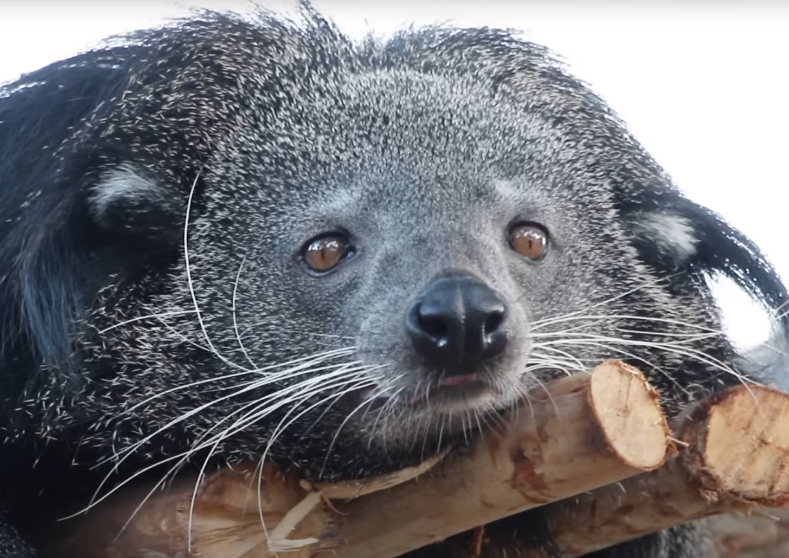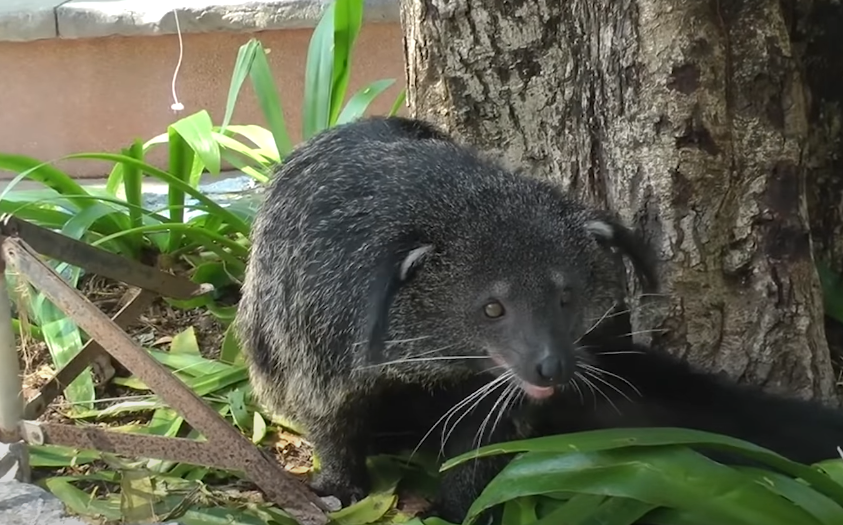The binturong, also known as the bearcat, is a unique and intriguing mammal that has captured the curiosity of wildlife enthusiasts and zoo visitors alike. These enigmatic creatures are part of the family Viverridae and are scientifically known as Arctictis binturong. With their shaggy fur and prehensile tail, binturongs are a remarkable example of nature’s diversity. This article delves into the captivating world of binturongs, exploring their natural habitat, their significance in conservation, their adaptive features, and their presence in zoos.

What is the Natural Habitat of the Binturong?
Where Can Binturongs Be Found in the Wild?
Binturongs are native to the dense rainforests of South and Southeast Asia, including countries like Thailand, Malaysia, Indonesia, the Philippines, and Myanmar. They are arboreal mammals, meaning they spend most of their lives in the trees, navigating through the canopy with agility. Their habitat is characterized by tropical climates with high humidity and abundant vegetation, which provides ample food sources and shelter. These environments are essential for the survival of binturong populations, allowing them to forage for a variety of fruits, small animals, and other food items.
How Does Habitat Loss Affect Binturongs?
The primary threat to binturongs in the wild is habitat loss due to deforestation and human encroachment. As rainforests are cleared for agriculture, logging, and urban development, the natural habitat of the binturong is being destroyed at an alarming rate. This loss of habitat not only reduces the available space for these animals to thrive but also diminishes their access to food sources and breeding grounds. Consequently, binturongs are becoming increasingly vulnerable, with many populations declining rapidly. The IUCN Red List currently classifies binturongs as “vulnerable,” highlighting the urgent need for conservation efforts to protect these unique creatures from further endangerment.
What Role Do Rainforests Play in Their Survival?
Rainforests play a crucial role in the survival of binturongs, providing a rich and diverse ecosystem that supports their dietary and shelter needs. These lush environments are home to a variety of fruits and small animals, such as rodents and birds, which form the core of the binturong’s carnivore diet. Additionally, rainforests offer the perfect habitat for binturongs to exhibit their arboreal lifestyle, using their prehensile tail to maneuver through the trees with ease. The presence of strangler figs and other fruit-bearing plants is particularly important, as binturongs rely heavily on figs for sustenance, contributing to seed dispersal and the ecological health of their habitat.
Why is the Binturong Important to Wildlife Conservation Efforts?
What Are the Main Threats to Binturongs in the Wild?
Binturongs face several threats in the wild, with habitat loss being the most significant. Additionally, poaching and the illegal pet trade pose serious risks to their survival. Binturongs are often hunted for their fur and meat, and their capture for the pet trade further diminishes wild populations. This exploitation, coupled with habitat destruction, places immense pressure on binturongs, making conservation efforts critical for their continued existence.
How Do Conservation Efforts Help Protect Binturongs?
Conservation efforts are vital to safeguarding the future of binturongs. Organizations like ABCONservation and various wildlife sanctuaries work tirelessly to protect these animals by preserving their natural habitats and implementing breeding programs to boost population numbers. Camera traps and other monitoring tools are used to study binturong behavior and ecology, providing valuable data to inform conservation strategies. By raising awareness and promoting sustainable practices, these efforts aim to mitigate the impact of human activities on binturong habitats.
What Can Individuals Do to Support Binturong Conservation?
Individuals can play a significant role in binturong conservation by supporting organizations dedicated to wildlife protection and advocating for sustainable practices. Educating others about the importance of rainforests and the threats faced by binturongs can help generate broader awareness and action. Additionally, responsible consumer choices, such as purchasing products from companies that prioritize environmental sustainability, can reduce the demand for resources that contribute to habitat destruction.

How Does the Binturong Adapt to Its Environment?
What is Unique About the Binturong’s Prehensile Tail?
The binturong’s prehensile tail is one of its most distinguishing features, functioning as an extra limb to aid in climbing and balance. This tail, which can be as long as the binturong’s body, is covered in shaggy fur and is strong enough to support the animal’s weight. It allows binturongs to grasp branches securely, enabling them to navigate the forest canopy with precision and ease. This adaptation is essential for their arboreal lifestyle, providing both mobility and safety in their treetop habitat.
How Does the Binturong’s Diet Reflect Its Carnivore Nature?
Despite being classified as a carnivore, the binturong’s diet is quite varied and omnivorous. In the wild, binturongs consume a range of foods, including fruits like figs, small animals, eggs, and plant material. This diverse diet reflects their ability to adapt to available resources and is crucial for their survival in changing environments. Their sharp claws and strong jaws allow them to hunt and forage effectively, securing the nutrition they need to thrive in their natural habitat.
Why Do Binturongs Smell Like Buttered Popcorn?
One of the most fascinating aspects of the binturong is its distinctive smell, often compared to buttered popcorn or corn chips. This unique scent is produced by a gland located under the tail, which secretes a substance used for marking territory and communication. The aroma serves as a social signal, helping binturongs identify each other and establish boundaries within their environment. This olfactory adaptation is a testament to the binturong’s complex social behaviors and interactions within its species.
Are Binturongs Kept in Zoos and Why?
How Do Zoos Contribute to Binturong Conservation?
Zoos play a crucial role in the conservation of binturongs by providing a safe haven for these animals and facilitating breeding programs. These programs are designed to maintain genetic diversity and increase population numbers, contributing to the long-term survival of the species. By participating in global conservation networks, zoos help raise awareness about the threats facing binturongs and the importance of preserving their natural habitats. Educational programs and exhibits further enhance public understanding and appreciation of these unique creatures.
What Can Visitors Learn About Binturongs at the Zoo?
Visitors to zoos can learn a great deal about binturongs, gaining insights into their behavior, diet, and ecological significance. Educational displays and interactive exhibits provide information about the binturong’s natural habitat, the challenges they face in the wild, and the conservation efforts in place to protect them. By observing binturongs in a controlled environment, visitors can appreciate their physical adaptations, such as their prehensile tails and distinctive scent-marking behaviors, fostering a deeper connection to wildlife conservation.
What are the Challenges of Keeping Binturongs in Captivity?
While zoos offer valuable conservation opportunities, keeping binturongs in captivity presents several challenges. Providing an environment that mimics their natural habitat as closely as possible is essential for their well-being. This includes offering ample space for climbing and exploring, as well as a diet that reflects their nutritional needs. Behavioral enrichment is crucial to prevent boredom and stress, ensuring that captive binturongs remain active and engaged. Zoos must balance these needs with the logistical and financial constraints of maintaining specialized enclosures and care programs.
What Are Some Interesting Facts About Binturongs?
Is the Binturong Related to Bears or Cats?
Despite their nickname “bearcat,” binturongs are not closely related to bears or cats. Instead, they belong to the family Viverridae, which includes civets and genets. This classification places them in a unique position within the animal kingdom, exhibiting characteristics that are reminiscent of both bears and cats but are distinctively their own. Their bear-like appearance and cat-like climbing abilities have contributed to their common name, but their true relatives are found within the viverrid family.
How Does Delayed Implantation Affect Binturong Reproduction?
Binturongs exhibit a reproductive phenomenon known as delayed implantation, where the fertilized egg does not immediately implant in the uterine wall. This delay allows female binturongs to time the birth of their offspring to coincide with optimal environmental conditions, increasing the chances of survival. This adaptation is particularly advantageous in unpredictable climates or when food resources fluctuate, ensuring that young binturongs enter the world when conditions are most favorable.
What Are the Unique Characteristics of the Female Binturong?
Female binturongs possess several unique characteristics that distinguish them from their male counterparts. Notably, females are typically larger, weighing about 20% more than males. This size difference is thought to be an adaptation for supporting the demands of reproduction and nurturing offspring. Additionally, female binturongs play a critical role in social structures, often leading group dynamics and establishing territories. Their robust presence and maternal instincts are vital to the stability and continuation of binturong populations.
